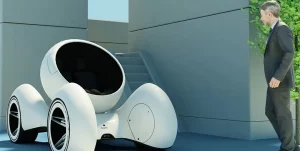Apple has somehow come to realize and has decided to let go of the idea of a ‘Fully self-driving car’ and also has postponed the car’s target launch date by about a year to 2026. The car project is called Titan inside the company and Apple executives have grappled with the reality that its vision for a fully autonomous vehicle without a steering wheel or pedals is not something mankind can achieve any time soon.
Apple is still trying to gather the idea of a remote command center to assist drivers and control cars from afar during emergencies. The company is also discussing offering its own insurance program to customers. Apple had expected each car to sell for more than $120,000, but the company is now aiming to offer the vehicle to consumers for less than $100,000, according to the people. That would put it in roughly the same price range as the entry-level version of the Model S from Tesla and the EQS from Mercedes-Benz.
The company is now planning a less-ambitious design that will include a steering wheel and pedals and only support fully autonomous capabilities on highways. Apple faces a challenge in pushing into an entirely new product category and taking on technological obstacles that have bedeviled some of the world’s biggest companies. The secretive project, underway for years, is meant to provide Apple with another major moneymaker, but it also could test the limits of the iPhone maker’s capabilities.
Apple currently plans to develop a vehicle that lets drivers watch a movie or play a game on a freeway and be alerted to switch over to manual control if they reach city streets or encounter inclement weather. The company has discussed launching the feature in North America initially and then improving and expanding it over time.
Apple’s previous vision for the car was to offer Level 5 autonomy the pinnacle of self-driving technology, which no automaker has attained. The current plan is considered below that because of its more limited scope.
The current leader of the Apple car team, Kevin Lynch has aimed to bring more stability and a focus on practical goals after years of priority changes and even some layoffs. Lynch took over at the end of 2021 and initially instructed the team working on the car, known as the Special Projects Group, to focus on a fully autonomous vehicle for a debut by 2025. Now he’s dialing back those expectations, but with the goal of ensuring that a product actually reaches the market.
Apple technology’s main focus is a powerful onboard computer system, codenamed Denali after the tallest mountain peak in North America, and a custom array of sensors. The processor’s performance is equal to about four of Apple’s highest-end Mac chips combined and is being developed by the company’s silicon engineering group. The chip has reached an advanced state and is considered nearly production-ready, though Apple may scale it down before the car’s launch to lower costs.
Apple car organization is made up of about 1,000 employees over different offices in Sunnyvale, California; Ottawa; Zurich; and Arizona. Much of the underlying engineering work, industrial design, and software development is done in Sunnyvale, while parts of the car’s future operating system are developed in Ottawa, an area where the company poached workers from BlackBerry’s QNX, a longtime maker of car software, in 2016.
A team in Zurich is developing a tool known as “Rocket Score” that grades the vehicle’s autonomous system. That core team faced a setback earlier this year when Ian Goodfellow, a prominent developer of AI technology who helped lead the group, left Apple after complaining about its work-from-home policies.
Other than the onboard hardware, the system has a cloud-based component for some artificial intelligence processing. Apple is relying on Amazon Web Services for hosting, costing the iPhone maker about $125 million per year. But that’s just a sliver of the roughly $1 billion the company is spending on the car project annually.
Apple hasn’t yet settled on a design for its car and the vehicle is considered to be in the “pre-prototype” stage. The company is aiming to ready the design by next year and have the features set by the end of 2024. It then plans to put the car through extensive testing in 2025.
Apple had previously discussed launching a car that looks similar to Canoo’s Lifestyle Vehicle. The idea was to have a limousine-like interior where passengers could face each other. Now the plan is to produce something more like a traditional car, with a driver’s seat. The company has held discussions with a number of suppliers about obtaining an electric-vehicle platform, known in the industry as a “skateboard,” but it’s still seeking a partner.
Apple earlier talked to several companies about licensing their platforms, but the only serious negotiations occurred with Volkswagen several years ago. EV platforms include the underlying base of the car, the wheel system, and the battery.
The design of the car is being led by Ulrich Kranz, the ex-CEO of Canoo, as well as former managers from Tesla, Lamborghini, and Porsche. The software side of the system is led by former Tesla manager Stuart Bowers, while safety engineering, testing, and regulatory matters are handled by ex-Ford executive Desi Ujkashevic.
Read More:
The post Apple Decides To Add Wheels And Pedals In Its ‘Self-Driving’ Car appeared first on TechJuice.
from TechJuice https://ift.tt/TFmeiYJ





0 Comments